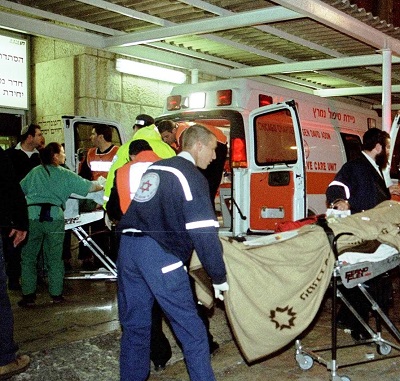
The winter sun has set and outside the Swartz Center for Emergency Medicine (CEM) at Hadassah Hospital. The TV cameramen are zipping their jackets as they wait for the blinking lights and sirens of the ambulance. One of the injured is already inside—a young man who had been stabbed by a terrorist.
The terrorist, allegedly associated with Islamic jihad, had driven his vehicle into a bus stop, aiming to kill. When his minivan hit an obstruction, he jumped out and had begun to stab people when a security guard from Allon Shvut, a nearby small town, shot him. The terrorist ran away after being shot, but the guard pursued him and shot him again. He will be coming in the second ambulance.
The ambulance parks near the entrance of the CEM. Medics hurry around the back and carry a swarthy, bloodied man on a stretcher into the trauma center.
“The terrorist,” whispers a woman in the waiting room near ambulatory care. “It must be the terrorist.”
Heavily armed soldiers and police follow the stretcher. Doctors, nurses, auxiliary staff, soldiers and police crowd into the trauma room.
I am there, too, watching. The scene feels eerily familiar. There is famed trauma surgeon “Avi Rivkind” orchestrating the care.
The trauma unit had been built in the wake of the Second Intifada, from 2000-2005, when half of the terror victims in the country were treated in Hadassah’s hospitals.
The terrorist is placed in the far left bay; the man he’d stabbed is to the right.
How many times have I explained that we treat Jew and Arab, even terror victim and terrorist, exactly the same?
Rivkind, in a sky blue shirt, is in charge, quietly asking questions, looking for good answers, giving orders.
The terror victim needs a CAT scan. The terrorist might have a bullet in his heart. The imaging technicians and the cardio-thoracic surgeon are summoned. A senior orthopedic surgeon stands by. In a land where the Prime Minister is called by his nickname Bibi and the Chief of Staff is called Benny, first names are enough. In the Shock Trauma Center there is Avi and Yoav and Rami and Shaul, Ami and Naomi and Tamar. There is also Abed and Osama on this team, struggling together to save the lives of these patients. A tall hematologist with glasses joins the group. Alex.
 A group of physicians hover over the computer to interpret the tests. Will the terrorist need heart surgery? The Hospital Director phones in a request to have operating room number eight readied. Just in case.
A group of physicians hover over the computer to interpret the tests. Will the terrorist need heart surgery? The Hospital Director phones in a request to have operating room number eight readied. Just in case.
The terror victim’s stab wounds are evaluated. One of the doctors says the first CAT scan is different from the second. They need to wait and see what develops. His family has arrived.
The specialists who were supposed to be doing late-afternoon clinics ask for phone calls to be made to cancel their patients. This will take a while.
There is news of another possible stabbing and an injury from a bus stoning. The empty bays of the trauma center don’t need to be readied. They are always ready.
Should the blood-soiled bandages be dumped, the orderly asks the police. No. They want everything.
Eighteen physicians—among them Hadassah’s most experienced—stand around the terrorist. The cardiothoracic surgeon reads the test results. No heart surgery needed. The bullet isn’t in the heart. The surgeon orders an angiogram. The terrorist is wheeled out. The orthopedists won’t deal with broken bones now. They can come back later.
Suddenly the action is over—or at least paused. The specialists begin to leave. Avi Rivkind washes the blood from his hands.
The news reports that the first victim of the attack, Dalia Lemkus, 26, died of her wounds on the site after being run over and stabbed numerous times.
The terrorist is identified as Maher Hadi a-Hashalmoun from Hebron. He spent almost five years in Israeli jail for throwing Molotov cocktails.
The TV cameras have moved to the atrium of the Sarah Wetsman Davidson Tower. It’s too cold and dark outside. Deputy Director Dr. Ashi Salmon—who is called Shalmon in Hebrew — oddly similar to the terrorist’s name — is speaking before TV cameras. Channel 2, Channel 1, and Channel 10 are all there. Patients from three other attacks are still at the hospital, he tells them.
Patients are waiting for care at the Emergency Room walk-in service. Some are wearing kefiyyas (an Arab headdress), others streimels (hats used by ultra-religious Jews). Some are bare-headed.
They are treated the same: Arab and Jew, religious and secular, and even terror victim and terrorist. The same, the same, the same….
Barbara Sofer, Jerusalem
